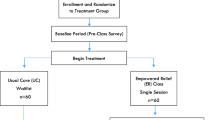Abstract
The aim of the study was to evaluate an educational video designed to modify the pain concept of chronic pain patients. It is commonly described that chronic pain patients foster an illness model which is dominated by purely medical assumptions about causes of pain and its modulation and treatment. Furthermore the mostly unrealistic hope for total pain relief which is expected from the pain expert guides the patients' seek for help. These concepts are most probable very dysfunctional in a multidisciplinary pain management setting, where psychological interventions are important elements of the treatment. Therefore the video was designed to initiate changes in the patient's attitude towards a multimodal model of pain. The educational pain video was evaluated in an experimental design using a control group to whom a different video on a health related topic (nutrition) was presented. The Ss participating in the study were 47 chronic pain patients of a pain ambulance and 42 patients of a pain clinic (inpatient setting). The results showed that after viewing the pain video the groups differed significantly in their pain concept as predicted. The use of an educational video, like the one evaluated, seems useful to initiate first steps in illness concept modification by expanding and enriching the patients attitude by assumptions about the influence of psychological factors on pain maintenance and management and shaping realistic attitudes towards treatment.
Zusammenfassung
Anliegen der Studie war die Entwicklung und Erprobung einer Medieneinheit (Video) zur Veränderung der Krankheitstheorie chronischer Schmerzpatienten unmittelbar vor Aufnahme der Behandlung in einer multidisziplinär ausgerichteten schmerztherapeutischen Institution. Ziel der Edukation war, die Akzeptanz der Patienten für eine multifaktorielles Bedingungskonzept chronischer Schmerzen und eine multimodale Therapie unter Einschließung psychologischer Interventionen zu erhöhen und realistische Behandlungserwartungen auszubilden. Die Medieneinheit wurde als Videofilm konzipiert, der in einem experimentellen Versuchsplan mit Versuchs- und Kontrollgruppe an 2 verschiedenen Stichproben von Schmerzpatienten (Klinik/Ambulanz) auf ihre Wirkung geprüft wurde. Die Ergebnisse unterstreichen die Nützlichkeit des Films, erste Veränderungen im Schmerzkonzept chronischer Patienten in Gang zu setzen.
Similar content being viewed by others
Literatur
Basler HD, Franz C, Kröner-Herwig B, Rehfisch HP, Seemann H (Hrsg) (1990) Psychologische Schmerztherapie: Grundlagen, Krankheitsbilder, Behandlung. Springer, Berlin Heidelberg New York
Bonica JJ (ed) (1990) The management of pain. Vol I, II Lea & Febinger, New York
Brand J (1982) Kontrollerwartung, Ursachenattribution und psychische Störung. Z Klin Psych 11:155–176
Cooley WW, Lohnes PR (1971) Multivariate data analysis. Wiley, New York
DeGood DE (1983) Reducing medical patients' reluctance to participate in psychological therapies: The initial session. Professional Psychology: Res Pract 14:570–579
Flor H, Birbaumer N, Turk DC (1990) The psychobiology of chronic pain. Adv Behav Res Ther 12:47–84
Försterling F (1986) Attributionstheorie in der Klinischen Psychologie. Psychologie Verlagsunion, Frankfurt
Frettlöh J, Brinkmann R (1987) Subjektive Theorien über Migräne. Eine explorative Studie über die Alltagstheorien betroffener psychologisch nicht-behandelter und behandelter Frauen. Unveröffentlichte Diplomarbeit, Ruhruniversität Bochum
Hatch JP, Fisher JG, Rugh JD (eds) (1987) Biofeedback: Studies in clinical efficacy. Plenum, New York
Kröner-Herwig (1990) Schmerzbehandlungszentren in den USA: Organisation, Therapieprogramme, Effizienz. In: Basler et al. (Hrsg) (1990) Psychologische Schmerztherapie: Grundlagen, Krankheitsbilder, Behandlung. Springer, Berlin Heidelberg New York, pp 518–538
Lienert GA (1967) Testaufbau und Testanalyse. Beltz, Weinheim
Linton SJ (1986) Behavioral remedation of chronic pain: A status report. Pain 24:125–141
Lohaus A, Schmitt GM (1989) Fragebogen zur Erhebung von Kontrollüberzeugungen zu Krankheit und Gesundheit (KKG). Handanweisung. Hogrefe, Göttingen
Lutz RW, Silbert M, Olsham N (1983) Treatment outcome and compliance with therapeutic regimens: Long term followup of a multidisciplinary pain program. Pain 17:301–308
Melzack R, Wall PD (1965) Pain mechanisms: A new theory. Science 50:971–979
Parsons T (1951) The social system. Glencoe, New York
Petty R, Cacioppo J (1981) Personal involvement as a determination of argument—based persuasion. J Pers Soc Psychol 41:847–855
Reading AE (1982) Attribution and the management of the pain patients. In: Antaki C, Brewin C (eds) Attributions and psychological change. Academic Press, London, pp 157–174
Schwartz DP, DeGood DE, Shutty MS (1985) Direct assessment of beliefs and attitudes of chronic pain patients. Arch Phys Med Rehabil 66:806–809
Shutty MS, DeGood DE (1990) Patient knowledge and beliefs about pain and its treatment. Rehabil Psychol 35:43–54
Turk DC, Meichenbaum D, Genest M (1983) Pain and behavioral medicine: A cognitive behavioral perspective. Guilford, New York
Turner JA, Chapman CR (1982) Psychological interventions for chronic pain: a critical review. I. Relaxation and biofeedback. Pain 12:1–21
Turner JA, Chapman CR (1982) Psychological interventions for chronic pain: A critical review. II. Operant conditioning, hypnosis, and cognitive-behavioral therapy. Pain 12:23–46
Vasudevan SV (1988) Management of chronic pain: What have we achieved in the last 25 years? In: Ghia JN (ed) The multidisciplinary pain center. Kluwer, Boston, pp 85–118
Watts FN (1982) Attributional aspects of medicine. In: Antaki C, Brewin C (eds) Attributions and psychological change. Academic Press, London, pp 135–155
Author information
Authors and Affiliations
Additional information
Die Studie wurde von der DFG gefördert (KR 756)
Rights and permissions
About this article
Cite this article
Kröner-Herwig, B., Lucht, S. Veränderung des Schmerzkonzepts bei chronischen Schmerzpatienten durch Einsatz eines edukativen Videofilms. Schmerz 5, 70–77 (1991). https://doi.org/10.1007/BF02529471
Issue Date:
DOI: https://doi.org/10.1007/BF02529471




